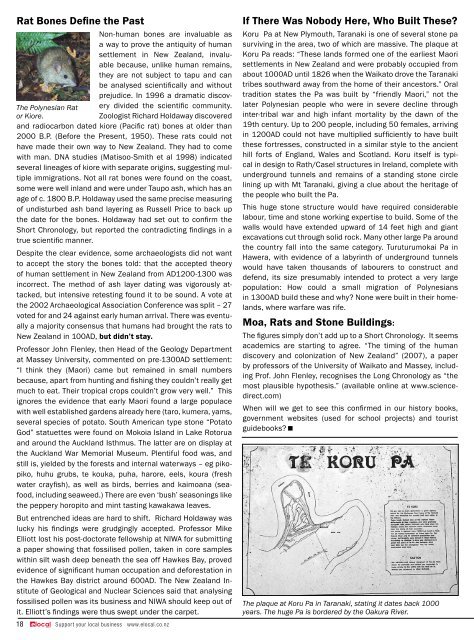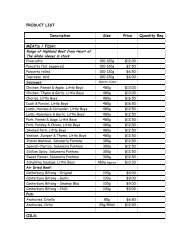Full Download - Elocal.co.nz
Full Download - Elocal.co.nz
Full Download - Elocal.co.nz
Create successful ePaper yourself
Turn your PDF publications into a flip-book with our unique Google optimized e-Paper software.
Rat Bones Define the Past<br />
Non-human bones are invaluable as<br />
a way to prove the antiquity of human<br />
settlement in New Zealand, invaluable<br />
because, unlike human remains,<br />
they are not subject to tapu and can<br />
be analysed scientifically and without<br />
prejudice. In 1996 a dramatic dis<strong>co</strong>very<br />
divided the scientific <strong>co</strong>mmunity.<br />
Zoologist Richard Holdaway dis<strong>co</strong>vered<br />
and radiocarbon dated kiore (Pacific rat) bones at older than<br />
2000 B.P. (Before the Present, 1950). These rats <strong>co</strong>uld not<br />
have made their own way to New Zealand. They had to <strong>co</strong>me<br />
with man. DNA studies (Matisoo-Smith et al 1998) indicated<br />
several lineages of kiore with separate origins, suggesting multiple<br />
immigrations. Not all rat bones were found on the <strong>co</strong>ast,<br />
some were well inland and were under Taupo ash, which has an<br />
age of c. 1800 B.P. Holdaway used the same precise measuring<br />
of undisturbed ash band layering as Russell Price to back up<br />
the date for the bones. Holdaway had set out to <strong>co</strong>nfirm the<br />
Short Chronology, but reported the <strong>co</strong>ntradicting findings in a<br />
true scientific manner.<br />
Despite the clear evidence, some archaeologists did not want<br />
to accept the story the bones told: that the accepted theory<br />
of human settlement in New Zealand from AD1200-1300 was<br />
in<strong>co</strong>rrect. The method of ash layer dating was vigorously attacked,<br />
but intensive retesting found it to be sound. A vote at<br />
the 2002 Archaeological Association Conference was split – 27<br />
voted for and 24 against early human arrival. There was eventually<br />
a majority <strong>co</strong>nsensus that humans had brought the rats to<br />
New Zealand in 100AD, but didn’t stay.<br />
Professor John Flenley, then Head of the Geology Department<br />
at Massey University, <strong>co</strong>mmented on pre-1300AD settlement:<br />
“I think they (Maori) came but remained in small numbers<br />
because, apart from hunting and fishing they <strong>co</strong>uldn’t really get<br />
much to eat. Their tropical crops <strong>co</strong>uldn’t grow very well.” This<br />
ignores the evidence that early Maori found a large populace<br />
with well established gardens already here (taro, kumera, yams,<br />
several species of potato. South American type stone “Potato<br />
God” statuettes were found on Mokoia Island in Lake Rotorua<br />
and around the Auckland Isthmus. The latter are on display at<br />
the Auckland War Memorial Museum. Plentiful food was, and<br />
still is, yielded by the forests and internal waterways – eg pikopiko,<br />
huhu grubs, te kouka, puha, harore, eels, koura (fresh<br />
water crayfish), as well as birds, berries and kaimoana (seafood,<br />
including seaweed.) There are even ‘bush’ seasonings like<br />
the peppery horopito and mint tasting kawakawa leaves.<br />
But entrenched ideas are hard to shift. Richard Holdaway was<br />
lucky his findings were grudgingly accepted. Professor Mike<br />
Elliott lost his post-doctorate fellowship at NIWA for submitting<br />
a paper showing that fossilised pollen, taken in <strong>co</strong>re samples<br />
within silt wash deep beneath the sea off Hawkes Bay, proved<br />
evidence of significant human occupation and deforestation in<br />
the Hawkes Bay district around 600AD. The New Zealand Institute<br />
of Geological and Nuclear Sciences said that analysing<br />
fossilised pollen was its business and NIWA should keep out of<br />
it. Elliott’s findings were thus swept under the carpet.<br />
18 elocal<br />
.<strong>co</strong>.<strong>nz</strong><br />
Support your local business www.elocal.<strong>co</strong>.<strong>nz</strong><br />
If There Was Nobody Here, Who Built These?<br />
Koru Pa at New Plymouth, Taranaki is one of several stone pa<br />
surviving in the area, two of which are massive. The plaque at<br />
Koru Pa reads: “These lands formed one of the earliest Maori<br />
settlements in New Zealand and were probably occupied from<br />
about 1000AD until 1826 when the Waikato drove the Taranaki<br />
tribes southward away from the home of their ancestors.” Oral<br />
tradition states the Pa was built by “friendly Maori,” not the<br />
later Polynesian people who were in severe decline through<br />
inter-tribal war and high infant mortality by the dawn of the<br />
19th century. Up to 200 people, including 50 females, arriving<br />
in 1200AD <strong>co</strong>uld not have multiplied sufficiently to have built<br />
these fortresses, <strong>co</strong>nstructed in a similar style to the ancient<br />
hill forts of England, Wales and S<strong>co</strong>tland. Koru itself is typical<br />
in design to Rath/Casel structures in Ireland, <strong>co</strong>mplete with<br />
underground tunnels and remains of a standing stone circle<br />
lining up with Mt Taranaki, giving a clue about the heritage of<br />
the people who built the Pa.<br />
This huge stone structure would have required <strong>co</strong>nsiderable<br />
labour, time and stone working expertise to build. Some of the<br />
walls would have extended upward of 14 feet high and giant<br />
excavations cut through solid rock. Many other large Pa around<br />
the <strong>co</strong>untry fall into the same category. Turuturumokai Pa in<br />
Hawera, with evidence of a labyrinth of underground tunnels<br />
would have taken thousands of labourers to <strong>co</strong>nstruct and<br />
defend, its size presumably intended to protect a very large<br />
population: How <strong>co</strong>uld a small migration of Polynesians<br />
in 1300AD build these and why? None were built in their homelands,<br />
where warfare was rife.<br />
Moa, Rats and Stone Buildings:<br />
The figures simply don’t add up to a Short Chronology. It seems<br />
academics are starting to agree. “The timing of the human<br />
dis<strong>co</strong>very and <strong>co</strong>lonization of New Zealand” (2007), a paper<br />
by professors of the University of Waikato and Massey, including<br />
Prof. John Flenley, re<strong>co</strong>gnises the Long Chronology as “the<br />
most plausible hypothesis.” (available online at www.sciencedirect.<strong>co</strong>m)<br />
When will we get to see this <strong>co</strong>nfirmed in our history books,<br />
government websites (used for school projects) and tourist<br />
guidebooks?
















